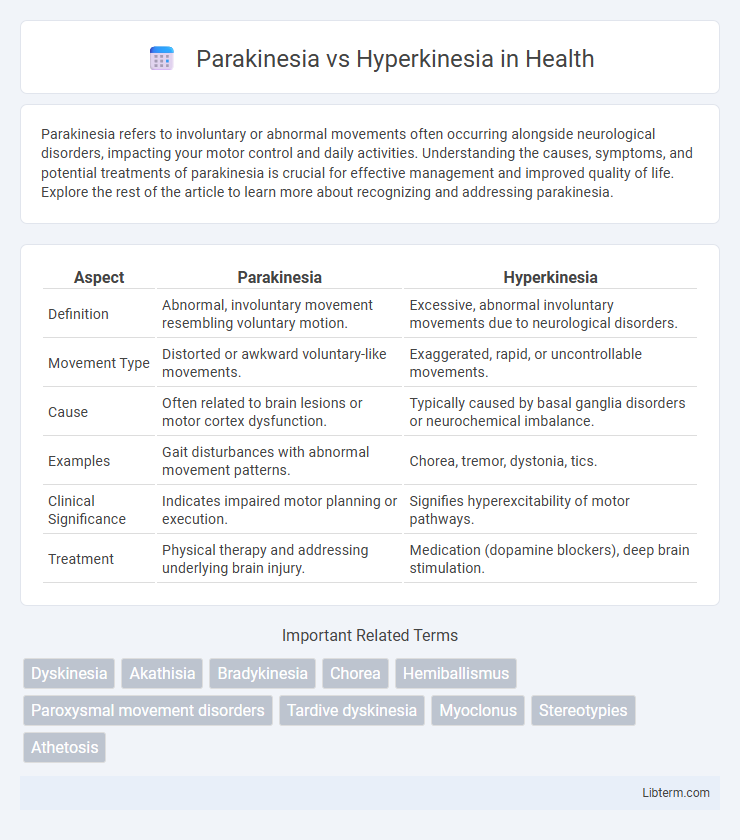Parakinesia refers to involuntary or abnormal movements often occurring alongside neurological disorders, impacting your motor control and daily activities. Understanding the causes, symptoms, and potential treatments of parakinesia is crucial for effective management and improved quality of life. Explore the rest of the article to learn more about recognizing and addressing parakinesia.
Table of Comparison
| Aspect | Parakinesia | Hyperkinesia |
|---|---|---|
| Definition | Abnormal, involuntary movement resembling voluntary motion. | Excessive, abnormal involuntary movements due to neurological disorders. |
| Movement Type | Distorted or awkward voluntary-like movements. | Exaggerated, rapid, or uncontrollable movements. |
| Cause | Often related to brain lesions or motor cortex dysfunction. | Typically caused by basal ganglia disorders or neurochemical imbalance. |
| Examples | Gait disturbances with abnormal movement patterns. | Chorea, tremor, dystonia, tics. |
| Clinical Significance | Indicates impaired motor planning or execution. | Signifies hyperexcitability of motor pathways. |
| Treatment | Physical therapy and addressing underlying brain injury. | Medication (dopamine blockers), deep brain stimulation. |
Introduction to Parakinesia and Hyperkinesia
Parakinesia refers to abnormal, involuntary movements that occur as a response to an underlying neurological condition, often manifesting as irregular muscle contractions or postural abnormalities. Hyperkinesia is characterized by excessive, uncontrollable movements, including tremors, tics, or chorea, typically associated with disorders such as Huntington's disease or Parkinsonism. Both parakinesia and hyperkinesia represent movement dysfunctions but differ fundamentally in their clinical presentation and underlying pathophysiology.
Defining Parakinesia: Key Features
Parakinesia involves abnormal, involuntary movements that occur as a response to voluntary motor commands, often seen in neurological conditions like Parkinson's disease. These movements differ from hyperkinesia, which refers to excessive, spontaneous motor activity such as chorea, tics, or tremors without a triggering voluntary action. Key features of parakinesia include its dependence on voluntary movement initiation and its atypical, sometimes compensatory motor behavior patterns.
Understanding Hyperkinesia: Main Characteristics
Hyperkinesia refers to excessive, involuntary movements that are often rapid and jerky, such as chorea, tremors, or tics, typically resulting from neurological disorders affecting the basal ganglia. This condition contrasts with parakinesia, which involves abnormal, voluntary-like movements that appear purposeful but are inappropriate or exaggerated. Key features of hyperkinesia include heightened muscle activity, disrupted motor control, and movement patterns that interfere with normal voluntary task execution.
Neurological Causes of Parakinesia
Parakinesia refers to involuntary, abnormal movements occurring as a response to voluntary motion, often linked to lesions in the basal ganglia or extrapyramidal system, while hyperkinesia denotes excessive, involuntary movements arising from imbalances in neurotransmitter systems, particularly dopamine. Neurological causes of parakinesia typically involve damage or dysfunction within the basal ganglia circuits, as seen in conditions such as Parkinson's disease, stroke, or traumatic brain injury, leading to disrupted motor control pathways. Understanding these mechanisms aids in differentiating parakinesia from hyperkinesia and tailoring specific therapeutic interventions targeting underlying neuropathologies.
Underlying Factors of Hyperkinesia
Hyperkinesia is primarily caused by disruptions in the basal ganglia, often resulting from neurodegenerative diseases such as Huntington's disease or Parkinson's disease with levodopa-induced dyskinesia. Imbalances in neurotransmitters like dopamine and GABA contribute to excessive involuntary movements characteristic of hyperkinesia. Unlike parakinesia, which involves abnormal voluntary movements, hyperkinesia stems from pathological changes in motor control circuits affecting movement regulation.
Clinical Symptoms: Parakinesia vs Hyperkinesia
Parakinesia is characterized by involuntary movements that emerge as compensatory responses to neurological damage, often appearing as abnormal posture or facial movements in Parkinson's disease. Hyperkinesia involves excessive, uncontrolled movements such as chorea, tics, or tremors, commonly seen in Huntington's disease and other basal ganglia disorders. While parakinesia reflects adaptive motor behavior, hyperkinesia represents pathological hyperactivity of motor pathways causing disruptive and excessive movements.
Diagnostic Approaches for Movement Disorders
Parakinesia and hyperkinesia are differentiated through clinical assessment protocols emphasizing specific movement patterns and triggers, with diagnostic approaches including detailed patient history, neurological examination, and movement analysis using video recordings. Advanced neuroimaging techniques like functional MRI and PET scans assist in identifying underlying structural or metabolic abnormalities influencing these movement disorders. Electrophysiological studies, such as EMG and EEG, further enhance diagnostic accuracy by evaluating muscle activity and brain wave patterns correlated with abnormal involuntary movements.
Treatment Options: Comparing Strategies
Treatment options for parakinesia often focus on addressing underlying causes such as stroke or Parkinson's disease, utilizing therapies like physical rehabilitation and medications including dopaminergic agents. Hyperkinesia management typically involves pharmacological interventions such as anticholinergics, benzodiazepines, and dopamine depleters to control involuntary movements, alongside behavioral and physical therapies. Deep brain stimulation is a common advanced treatment for refractory cases in both conditions, targeting motor control pathways in the basal ganglia.
Impact on Daily Life and Patient Quality
Parakinesia, often characterized by abnormal, involuntary movements triggered by specific conditions, impairs fine motor skills and complicates tasks like writing or buttoning clothes, significantly reducing patient autonomy. Hyperkinesia involves excessive, uncontrollable movements that can disrupt balance, speech, and coordination, leading to challenges in basic activities such as walking or eating. Both conditions negatively impact quality of life by increasing dependency and causing emotional distress, underscoring the need for targeted therapeutic interventions.
Summary and Future Directions
Parakinesia involves abnormal voluntary movement patterns often triggered by neurological impairments, whereas hyperkinesia is characterized by excessive involuntary movements such as chorea, dystonia, or tremor. Current research focuses on differentiating these disorders through advanced neuroimaging and electrophysiological techniques to better understand their distinct pathophysiologies. Future directions emphasize developing targeted therapies using neuromodulation and gene editing to improve motor control and reduce disability in affected patients.
Parakinesia Infographic

 libterm.com
libterm.com